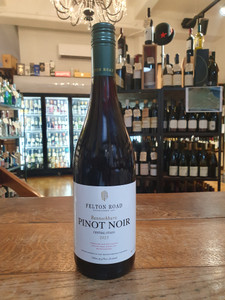
Tasting Note: Citrus blossom, elderflower and wet stones set the scene for this subtle yet beguiling Chardonnay. Comfortable, at ease with itself, not a single component vying for attention; just the Felton Road style at the fore. Deeply fruited with hazelnut notes through the mid, combined with characteristic fresh acidity, leads to a harmonious and sustained finish. A seamless Bannockburn blend from our Calvert, Cornish Point and The Elms vineyards.
Introduction: Commencing with meticulous site selection and vineyard design in 1991, Felton Road's story is one of refusal to compromise. A strict 100% estate policy with fully organic and biodynamic viticulture (BioGro and Demeter certified) ensures that our fruit arrives at the winery as pure as it can be, while our entire estate comes as close to true sustainability as is possible. The winery is also B Corp certified and a proud member of IWCA (International Wineries for Climate Action). A commitment to hands off winemaking: gravity flow, wild yeasts, wild malo, an avoidance of fining and filtration all help preserve the wine's expression of its terroir. The result is Riesling, Chardonnay and Pinot Noir which accurately express the authenticity and complexity of our unique vineyards. Gareth King; Viticulturist, Blair Walter; Winemaker, Nigel Greening; Vigneron.
Vineyard & Viticulture: Felton Road farms four properties totalling 34 ha in the Bannockburn subregion of Central Otago. Chardonnay is mostly grown on the Elms vineyard in Blocks 2, 6, 8 & 9, with approximately 10% coming from each of Cornish Point and Calvert vineyards. There are a range of altitudes and aspects, with the soils mostly deep schist gravels. Meticulous summer management of a single vertical shoot positioned (VSP) canopy ensures even and early fruit maturity. Shoot thinning, shoot positioning, leaf plucking, bunch thinning and harvest are all carried out by hand to ensure optimum quality fruit. Cover crops are planted between rows to assist in vine balance and to improve soil health and general biodiversity.
Vintage: After a wet September, spring commenced with good soil moisture and bud burst occurred at the normal time of early October. Temperatures hovered around average with December being warm and dry, enabling a successful flowering and fruit set. The dry conditions prevailed throughout January and February limiting berry size and setting the scene for fruit with elevated phenolic material and complexity. Judicious use of irrigation was required to maintain sufficient vine health throughout this sustained dry period. Temperatures never spiked and hovered around average enabling a slow and steady path to maturity. A distinctive feature of March 2024 was the cool night temperatures preserving acidity, freshness and precision of fruit character. Chardonnay was harvested from 18-27 March. Vinification Various clones of Chardonnay (Mendoza, B95, 548) were carefully hand harvested from Cornish Point, Calvert and The Elms vineyards. The grapes were whole bunch pressed with the juice flowing to barrel by gravity after overnight settling. Fermentation in French oak (mostly well-seasoned barrels with just 5% new) with indigenous yeasts has produced a wine with considerable complexity. A long and complete indigenous malolactic fermentation with only periodic stirring of the lees (Batonnage), combined with 11 months on full lees; has softened the acid for a rich and complex mouthfeel. In accordance with our non-interventionalist approach to winemaking, this wine was not fined or filtered after spending 13 months total in barrel.





